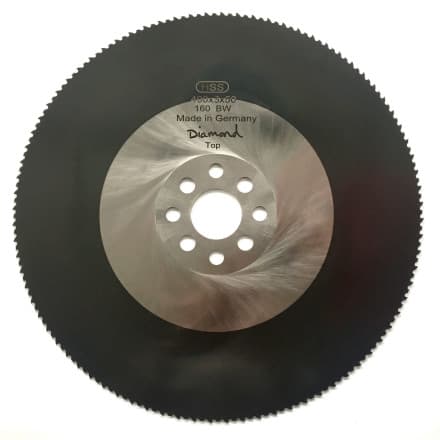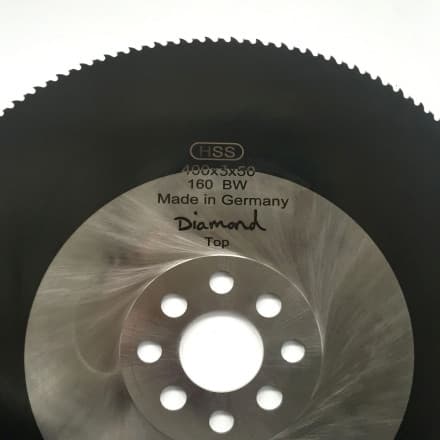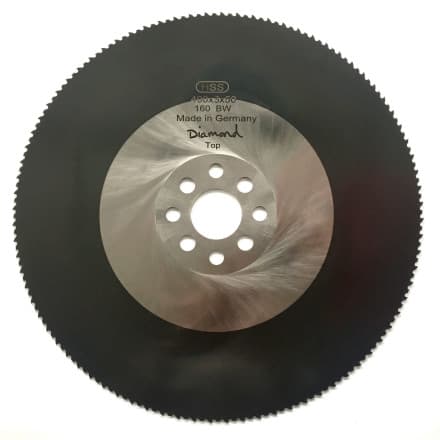A cold saw, also known as a metal cutting cold saw, is a term used to describe the cutting process of a metal circular saw. During the metal cutting process, the heat generated by the saw blade teeth cutting the workpiece is transferred to the sawdust, keeping the workpiece and saw blade cool. That's why it's called cold sawing.
Types of cold saws
There are two types of cold saw blades: high speed steel (HSS) blades and TCT alloy (tungsten carbide tip) blades.
The material of HSS blades mainly includes M2 and M35. The cutting speed of the blade is generally between 10-150 meters/second, depending on the material and specifications of the part to be cut.
HSS-coated blades can reach cutting speeds of up to 250 meters/minute.
The blade tooth feed rate is between 0.03-0.15mm/tooth, depending on the power, torque and quality of the sawing equipment.
The blade outer diameter specification is 50-650 millimeters with a blade hardness of HRC 65.
The blade can be sharpened and can typically be sharpened 15 to 20 times depending on the specifications of the piece being cut.
Blade cutting life can reach up to 0.3-1 square meter (cutting end face area) for larger HSS blade specifications.
Generally, inlaid HSS is used for blades over 2000 millimeters, with the saw teeth made of inlaid HSS material and the blade base made of vanadium or manganese steel.
The material of TCT alloy teeth is tungsten steel with a blade cutting speed generally between 60-380 meters/second depending on the material and specifications of the workpiece to be cut. The feed rate of tungsten steel blade teeth is between 0.04-0.08.
Blade specifications are 250-780 millimeters.
There are two types of TCT blades for cutting iron.
One has small teeth, thin blade, high cutting speed and long blade life, lasting approximately 15-50 square meters of cutting. It is a disposable blade.
The other has large teeth, thick blade, low cutting speed and is suitable for cutting large pieces, with blade diameter reaching more than 2,000 millimeters.
The blade life is generally around 8 square meters and can be sharpened 5 to 10 times.


Comparison
(Compared with manganese steel flying saw)
Cold saw cutting and friction cutting are different, mainly in the way of cutting:
Manganese Steel Flying Saw Blade: The manganese steel saw blade rotates at high speed to generate friction with the workpiece. The friction between the saw blade and the workpiece during the cutting process creates high temperatures that cause the contact welded pipe to break. This is actually a burning process, resulting in visible burn marks on the surface.
High Speed Steel Cold Cutting Saw: It depends on the slow rotation of the high speed steel saw blade to cut welded pipes, which can achieve smooth, burr-free and noise-free cutting results.
Benefits:
The cutting speed is fast, achieving great cutting efficiency and high working efficiency.
The blade deviation is low and there are no burrs on the cutting surface of the steel tube, thus improving the cutting accuracy of the workpiece and maximizing the blade life.
Using the cold milling and cutting method, very little heat is generated during the cutting process, which prevents changes in the internal stress and material structure of the cut section. At the same time, the blade exerts minimal pressure on the steel tube and does not cause deformation of the tube wall and mouth.
Parts processed with high-speed steel cold cutting saw have good end face quality:
- By adopting an optimized cutting method, the precision of the cut section is high and there are no internal or external burrs.
- The cutting surface is flat and smooth, without the need for subsequent processing such as chamfering (reducing the processing intensity of subsequent processes), saving processing steps and raw materials.
- The part will not change material due to the high temperature generated by friction.
- Operator fatigue is low, thus improving cutting efficiency.
- There are no sparks, dust or noise during the cutting process, which makes it environmentally friendly and energy-saving.
The service life is long and the blade can be sharpened repeatedly using a saw blade grinder. The useful life of a sharpened blade is the same as that of a new blade. This improves production efficiency and reduces costs.
Application technology:
Select sawing parameters based on the material and specifications of the workpiece to be cut:
- Determine the tooth pitch, tooth shape, front and back angle parameters of the saw teeth, blade thickness and blade diameter.
- Determine the sawing speed.
- Determine the tooth advancement rate.
The combination of these factors will result in reasonable cutting efficiency and maximum blade life.
Existence of the problem and its treatment
Vibration problem and its treatment
During the cutting process, there is a tendency for vibration to occur, which can lead to poor cutting effect, long periods of equipment inactivity, blade breakage during the cutting process, or other occurrences such as bearing burnout caused by uneven pressure on the spindle. The surface size and burrs of the saw-cut steel are out of tolerance.
Measures taken:
(1) Conventional method: In the installation process, leveling is adopted (setting the horizontal position of the upper sliding bracket and lower idler wheel based on the reference point), and the V-shaped wheels are aligned in a straight line using a wire drawing method, so that the idler wheel is at a uniform height and on the same line. Based on the force analysis of the upper sliding support, counterweights are added to the saw cover area to balance the force and ensure stable operation.
Steel Piling Problem and Its Treatment
During the cutting process, if the tension is uneven, the steel may pile up, especially when cutting small steel, which may cause damage to the saw blade and equipment.
Measures taken:
(1) An air pressure driven torque clamping device is installed on the cutting port to eliminate the piling phenomenon, protect the saw blade and reduce the reactive force generated by the deformation of steel under the radial force acting on the saw blade. mountain range.
(2) Support rollers are added to the cutting port, and after increasing the support rollers, they work together with the clamping device to pressurize the steel before cutting. This significantly improves the quality of the saw cutting surface and significantly reduces the damage rate of the saw blade.
The problem of large water spray area and its treatment
When entering the cold saw, the round steel is around 320℃ and water is sprayed to cool the saw blade during the cutting and retrieval processes. In actual production, the water spray area is very large, which causes the surface quality of steel to decrease and water to be wasted.
Measures taken:
(1) The original sprinkler tube is replaced with a spray tube. More nozzles are added and a mist spray method is used for main spraying at the cutting point. As the end of the nozzle has a concave surface in a circular arc, it can atomize water mist, uniform spraying and is easy to replace due to the use of threaded connections, which favors maintenance work.
(2) Use the surrounding cooling method to cool the saw cover, and cool the cutting port and cutting teeth in a targeted manner on the main parts.
(3) When feeding during cutting, a spray valve is used and the injection pressure is increased. The spray valve is closed during withdrawal.
Friction problem between saw cover and saw blade and its treatment
The friction between the saw cover and the saw blade causes the overall vibration of the upper slide support, which results in the loosening of the motor ground screw, and if this continues for a long time, it will directly cause burns to the bearing or motor.
Measures taken:
(1) The original saw cover shaft connection method was unreasonable, and the tension point of the saw cover pin shaft was on a side plate of the upper sliding support, which easily deformed the side plate and caused the saw cover tilts. By lengthening the pin axis and increasing the tension point, using the side plate as a fulcrum, and making the inner panel of the upper slide support the actual tension point, the structure of the saw cover has become more reasonable, avoiding similar accidents .
(2) When replacing the saw blade, the original method of using a crane to lift the saw cover can easily deform the cover. Now, hydraulic cylinders are used to lift the saw cover, and cushioning pads are added where the cover contacts the steel after the saw cover is turned over, which effectively solves the problem.

























































